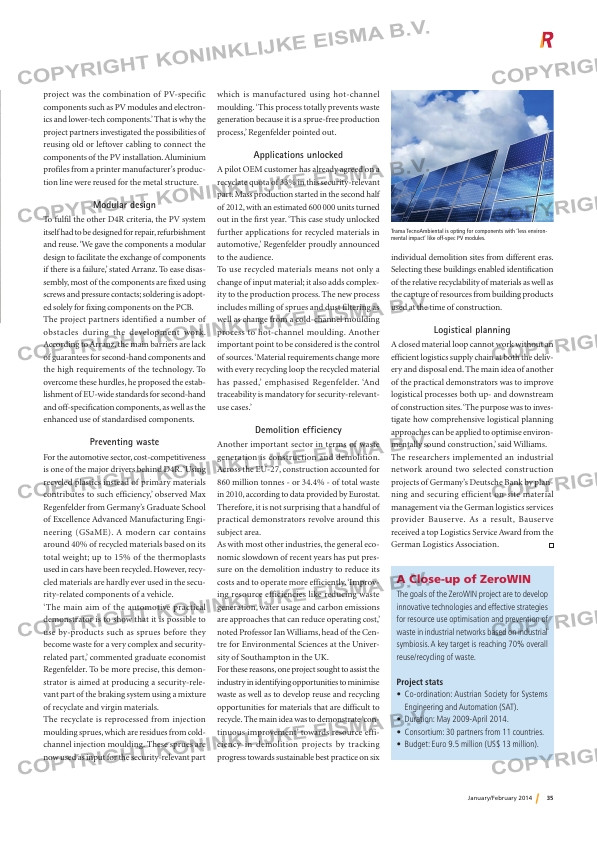Page 35 from: January / February 2014

35January/February 2014
project was the combination of PV-specific
components such as PV modules and electron-
ics and lower-tech components.’ That is why the
project partners investigated the possibilities of
reusing old or leftover cabling to connect the
components of the PV installation. Aluminium
profiles from a printer manufacturer’s produc-
tion line were reused for the metal structure.
Modular design
To fulfil the other D4R criteria, the PV system
itself had to be designed for repair, refurbishment
and reuse. ‘We gave the components a modular
design to facilitate the exchange of components
if there is a failure,’ stated Arranz. To ease disas-
sembly, most of the components are fixed using
screws and pressure contacts; soldering is adopt-
ed solely for fixing components on the PCB.
The project partners identified a number of
obstacles during the development work.
According to Arranz, the main barriers are lack
of guarantees for second-hand components and
the high requirements of the technology. To
overcome these hurdles, he proposed the estab-
lishment of EU-wide standards for second-hand
and off-specification components, as well as the
enhanced use of standardised components.
Preventing waste
For the automotive sector, cost-competitiveness
is one of the major drivers behind D4R. ‘Using
recycled plastics instead of primary materials
contributes to such efficiency,’ observed Max
Regenfelder from Germany’s Graduate School
of Excellence Advanced Manufacturing Engi-
neering (GSaME). A modern car contains
around 40% of recycled materials based on its
total weight; up to 15% of the thermoplasts
used in cars have been recycled. However, recy-
cled materials are hardly ever used in the secu-
rity-related components of a vehicle.
‘The main aim of the automotive practical
demonstrator is to show that it is possible to
use by-products such as sprues before they
become waste for a very complex and security-
related part,’ commented graduate economist
Regenfelder. To be more precise, this demon-
strator is aimed at producing a security-rele-
vant part of the braking system using a mixture
of recyclate and virgin materials.
The recyclate is reprocessed from injection
moulding sprues, which are residues from cold-
channel injection moulding. These sprues are
now used as input for the security-relevant part
which is manufactured using hot-channel
moulding. ‘This process totally prevents waste
generation because it is a sprue-free production
process,’ Regenfelder pointed out.
Applications unlocked
A pilot OEM customer has already agreed on a
recyclate quota of 33% in this security-relevant
part. Mass production started in the second half
of 2012, with an estimated 600 000 units turned
out in the first year. ‘This case study unlocked
further applications for recycled materials in
automotive,’ Regenfelder proudly announced
to the audience.
To use recycled materials means not only a
change of input material; it also adds complex-
ity to the production process. The new process
includes milling of sprues and dust filtering as
well as change from a cold-channel moulding
process to hot-channel moulding. Another
important point to be considered is the control
of sources. ‘Material requirements change more
with every recycling loop the recycled material
has passed,’ emphasised Regenfelder. ‘And
traceability is mandatory for security-relevant-
use cases.’
Demolition efficiency
Another important sector in terms of waste
generation is construction and demolition.
Across the EU-27, construction accounted for
860 million tonnes – or 34.4% – of total waste
in 2010, according to data provided by Eurostat.
Therefore, it is not surprising that a handful of
practical demonstrators revolve around this
subject area.
As with most other industries, the general eco-
nomic slowdown of recent years has put pres-
sure on the demolition industry to reduce its
costs and to operate more efficiently. ‘Improv-
ing resource efficiencies like reducing waste
generation, water usage and carbon emissions
are approaches that can reduce operating cost,’
noted Professor Ian Williams, head of the Cen-
tre for Environmental Sciences at the Univer-
sity of Southampton in the UK.
For these reasons, one project sought to assist the
industry in identifying opportunities to minimise
waste as well as to develop reuse and recycling
opportunities for materials that are difficult to
recycle. The main idea was to demonstrate ‘con-
tinuous improvement’ towards resource effi-
ciency in demolition projects by tracking
progress towards sustainable best practice on six
individual demolition sites from different eras.
Selecting these buildings enabled identification
of the relative recyclability of materials as well as
the capture of resources from building products
used at the time of construction.
Logistical planning
A closed material loop cannot work without an
efficient logistics supply chain at both the deliv-
ery and disposal end. The main idea of another
of the practical demonstrators was to improve
logistical processes both up- and downstream
of construction sites. ‘The purpose was to inves-
tigate how comprehensive logistical planning
approaches can be applied to optimise environ-
mentally sound construction,’ said Williams.
The researchers implemented an industrial
network around two selected construction
projects of Germany’s Deutsche Bank by plan-
ning and securing efficient on-site material
management via the German logistics services
provider Bauserve. As a result, Bauserve
received a top Logistics Service Award from the
German Logistics Association.
A Close-up of ZeroWIN
The goals of the ZeroWIN project are to develop
innovative technologies and effective strategies
for resource use optimisation and prevention of
waste in industrial networks based on industrial
symbiosis. A key target is reaching 70% overall
reuse/recycling of waste.
Project stats
• Co-ordination: Austrian Society for Systems
Engineering and Automation (SAT).
• Duration: May 2009-April 2014.
• Consortium: 30 partners from 11 countries.
• Budget: Euro 9.5 million (US$ 13 million).
Trama TecnoAmbiental is opting for components with ‘less environ-
mental impact’ like off-spec PV modules.
A second industrial revolution
RI-1-2014-Zero Win Project.indd 35 29-01-14 15:04



